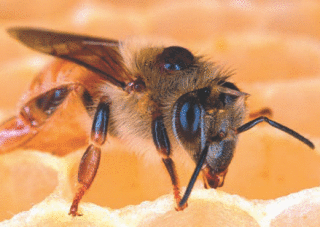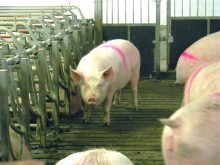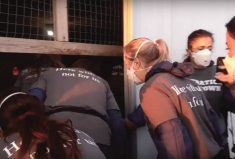 Canada’s corn and soybean industry are ready to meet proposed new safeguards to reduce bee deaths related to neonicotinoid insecticide seed treatments, industry officials say.
Canada’s corn and soybean industry are ready to meet proposed new safeguards to reduce bee deaths related to neonicotinoid insecticide seed treatments, industry officials say.
Health Canada’s Pest Management Regulatory Agency (PMRA) hopes to have the new measures in place by 2014. “We have concluded that current agricultural practices related to the use of neonicotinoid treated corn and soybean seed are not sustainable,” the agency said in a consultation document released Sept. 13.
Read Also

Mazergroup’s Bob Mazer dies
Mazergroup’s Bob Mazer, who helped grow his family’s company into a string of farm equipment dealerships and the main dealer for New Holland machinery in Saskatchewan and Manitoba, died July 6 from cancer.
“For the 2014 planting season, we intend to implement additional protective measures for corn and soybean production.”
The public has 90 days to comment on the proposals, which include changes to the pesticide label.
PMRA has found a link between the insecticide and bee deaths in Ontario and Quebec. It suspects dust created by lubricant used on seed to prevent it from clumping is carrying the insecticide to the bees.
CropLife Canada, which represents the companies that make neonicotinoids, supports reducing that dust.
“We’re a little disappointed in some of the language around those (PMRA) recommendations, but overall this focuses on the dust issue, which is a resolvable issue with the collaboration of the growers, our industry and other players,” said CropLife vice-president of chemistry Pierre Petelle.
“There’s a new product that should be available in 2014 that reduces dust by up to 90 per cent so that’s an innovation that should really help with the overall dust issue with corn and soybeans.”
PMRA noted bee mortality is complex and other factors including parasites, disease and climate. CropLife agrees, Petelle said
“We would’ve liked to see an initiative by the federal government to address some of these other factors of bee health,” he said. “That’s one disappointment.”
Neonicotinoids have been used in Canada for more than 10 years and benefit farmers. As seed treatments, they are intended to reduce the risk to beneficial insects such as bees, Petelle said.
“If we can deal with this one limited area of exposure through the dust then I think it’s a win-win for the industry,” he said.
The Manitoba Corn Growers Association hopes PMRA gives corn seed companies enough time to adjust, said association secretary-manager Theresa Bergsma.
“We don’t want to kill bees that’s for sure, we need them for pollination, but we need time to adjust,” she said.
Bergsma said she’s surprised that Manitoba is included in PMRA’s proposed changes given Manitoba beekeepers haven’t reported bee deaths from neonicotinoids. That could be because most corn in Manitoba is seeded before bees are active, she added.
Canola is not affected by PMRA’s proposals because treated canola seed doesn’t create as much dust, said Debbie Belanger, communications manager for the Canola Council of Canada.
The Manitoba Pulse Growers Association was still assessing PMRA’s proposal at press time.
PMRA said it will require updated value information be provided to support the continued need for neonicotinoid treatment on up to 100 per cent of corn seed and 50 per cent of soybean seed.
PMRA also announced it is “expediting” its previously announced re-evaluation of neonicotinoids, in co-operation with the U.S. Environmental Protection Agency (EPA). PMRA proposes to implement label changes similar to EPA’s
EPA’s planned changes, announced Aug. 15, calls for new pesticide labels that “prohibit use of some neonicotinoid pesticide products where bees are present.” The planned U.S. labels are to have a bee “advisory box and icon” with information on routes of exposure and drift precautions.
In February, PMRA announced a review of Canada’s approved neonicotinoids, which include clothianidin, thiamethoxam and imidacloprid, following reports of bee kills in Ontario and Quebec during the 2012 corn-planting season.
Then it proposed label amendments to take effect this year in time for 2014 planting, pointing out the potential hazard treated seed dust poses to bees and ways to mitigate it.
The amended labels include Bayer CropScience’s clothianidin seed treatment Poncho, Valent Canada’s clothianidin treatment NipsIt Inside, Syngenta Canada’s thiamethoxam-based Cruiser seed treatments, Bayer‚‘s imidacloprid-based Gaucho insecticides and Mana Canada‚‘s imidacloprid product Sombrero 600.
About 70 per cent of the affected dead bee samples PMRA tested contained neonicotinoids used to treat corn, while neonicotinoids were only detected in unaffected bees in one sample at “very low” levels.
PMRA concluded the majority of bee deaths resulted from exposure to neonicotinoid insecticides, likely through contaminated dust at planting.
Unusually warm and dry weather conditions in early spring were thought to be a contributing factor, PMRA said. Despite a more typical spring in 2013 PMRA said it “continued to receive a significant number of pollinator mortality reports from both corn- and soybean-growing regions of Ontario and Quebec, as well as Manitoba.”




















